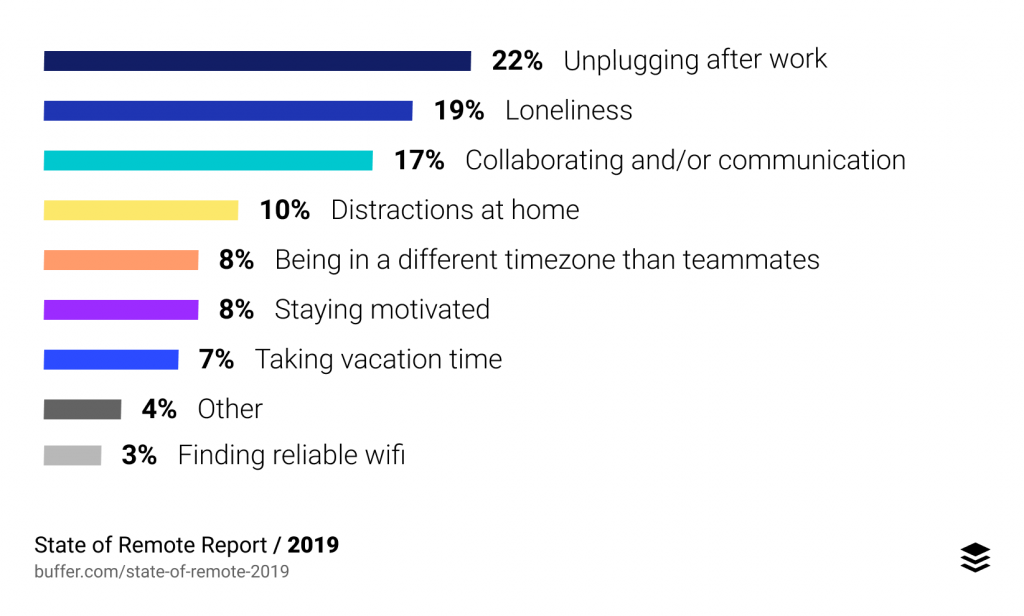Nowadays, remote working is a buzzword and many businesses are simply moving towards it without considering what it comes with. There are many perks of working remotely for professionals, but it also has some unique challenges. Most companies and employees are not prepared for this transition.
Are you ready for the transition to remote work? Or want to make remote working successfully for you?
Working from home or a remote location is also a skill that you need to develop like writing, designing, or programming. It takes considerable time, effort, and commitment.
IT, education & training, finance, sales, and customer service are some of the leading industries for remote workers. Also, various researches found that remote employees are more productive, healthier, and satisfied.
On the other side, there are some serious challenges of remote working that employees face. As per the 2019 State of Remote Work report of Buffer, unplugging after work, loneliness, communication & collaboration, and staying motivated are the most common issues in remote working.
 m
m
Now, it’s essential for both organizations and employees to understand the issues of remote working. In this blog, we are discussing 6 common remote work challenges along with their solutions. Read on!
Also Read: How to Motivate Your Employees While Working from Home During Lockdown
Highlights of Contents
Common Remote Working Challenges
Here we curate the issues that remote employees often experience while working out of the office.
1. Productivity & Tracking
One of the biggest problems of remote working is to maintain productivity. There are various reasons for this including the feeling of exhaustion, work overload, or insufficient personal time. These are a few negative effects that lead to a considerable decrease in employee productivity.
According to various studies, around 25% of remote workers work for longer hours. While around 15% employees feel they need an office to be productive.
![]()
Further, it’s a daunting job to keep track of separate tasks and meet the deadline. To meet the projects you need to ensure that all the smaller tasks get finished on time. Working remotely allows flexibility but it also requires you to be more organized and well prepared to meet the daily targets in an effective way.
How to prevent it and keep track of progress?
Track your time; time-tracking tools and apps can be helpful. They will allow you to determine how much time you have given to a particular task and use your time effectively.
Another useful tip here is to prioritize your tasks and complete them accordingly. You don’t need to sit all the time in front of the computer, take breaks, and get back to work full of verve.
Hubstaff, Trello, and Time Doctor are some of the best tools for effective time tracking, task management, and productivity monitoring.
2. Collaboration
Collaboration is a common issue that remote working teams report. When working on complex projects collaboration plays an important role and you can’t simply miss it.

And it’s a big challenge while working from home. You cannot interact with employees in your team with documents, designs, or other stuff due to some real limitations. There are situations when quick collaboration is really needed and visuals don’t work.
How to fix it and be collaborative?
As we are living in a technologically growing world, there are many collaboration tools designed to help you in effective remote co-working. These tools provide an effective communication channel and give you instant and responsive ways to collaborate.
Google Docs is a great, simple tool for real-time collaboration. It allows you to track changes and work from anywhere with auto-saving, file storage, and more features. While Zoom and Skype are effective for video calls, which is a good strategy to collaborate.
3. Communication
Why is communication essential for remote teams? It’s a big question and needs to be answered well.

In remote working, communication is one of the biggest challenges for one and all. When you work from home, you don’t get a chance to meet people face-to-face during breaks or when you need to talk about a project or task. A remote employee requires effective remote communication with his/her team or manager.
More than 50% of remote employees feel disconnected from in-office employees.
How to Meet Communication Gaps?
As a remote worker, you need to talk about your problems, expectations, and ask questions that are in your mind. Also, remote workers can benefit from different communication technology options.
There are several platforms on which remote employees can talk with their team about tasks, plans, and other things related to work. Skype and Slack are a few popular tools effective for communication while working remotely.
4. Interruptions
There are several interruptions and distractions you have to deal with when working from home. Young kids, pets, neighbors, and delivery persons are a few examples of it. Limited space and unrealistic family expectations are other distractions you need to handle. Moreover, finding a good place to attend audio/video calls is a serious issue at home.

How to overcome distractions at home?
It’s better to discuss with your family members about the disruptions. Despite various benefits of remote working, you need to be clear that it requires some discipline and dedication. Also, it’s a good idea to indicate to your family that you are working.
Choose a dedicated place in your home so that you can work peacefully. Set consistent work hours for tasks and don’t use social media while working.
5. Technology Issues
Technology is the key solution to your many problems, especially when working remotely. But there are some issues that you need to solve like slow or bad internet, poor equipment, or relevant apps and software. It’s important to choose the right tools and technologies for your work.

How to solve technical problems?
Conduct thorough research before using any app, software, or tool. And choose what is suitable for your work. Most importantly, you should always have a backup plan to avoid any delays.
With appropriate resources and by embracing technology, remote workers can improve their work efficiency and performance effectively.
6. Loneliness
Loneliness is a major issue with remote working and we can’t simply miss it out. This problem generally comes when there is nobody at your home with you or due to working in the same place for a long period. In remote working, you miss the moment of togetherness with your colleagues in the office.

For about 20% of remote employees, loneliness is the biggest challenge.
How to avoid isolation?
Remote workers need to talk about this problem with their team so as to maximize motivation. Further, remote working is about creating a balance between work and home. And it requires a lot of effort.
You need to include some breaks in your schedule, working for long hours is not good at all. Attend networking conferences and social meetings. Perform some leisure activities at home to avoid stress and feel good. For instance, your home garden is a perfect place to get some fresh air and thoughts too.
Co-working spaces are also good options for remote workers to stay connected with society.
Top employee monitoring softwares
Productivity Tools for every Industry
Final Thought
Herein, we have explored some of the most challenging aspects of remote working along with some proven solutions to that. Hope it may be helpful for you to make your remote working easier and more effective.
As a remote worker, you need to pay attention to these challenges to make remote working successfully for you. Once you get prepared for it, there are many benefits for you, such as better productivity, cost-saving, wellness, and more.
Thanks to the proven tools and working strategies that help to overcome the challenges of remote working. They will not only assist you in improving productivity but also support a work-life balance.
After seeing how COVID-19 is disrupting the business landscape, the concept of remote working and WFH is the need of the hour. Now, you should be better prepared for it.
Frequently Asked Questions (FAQs):
Q1- Is remote working good?
A1- Mostly, it is good as it offers various benefits for both employees and employers. Some of the common benefits include:
- Lower costs/Fewer expenses
- Improved employee retention
- Flexibility
- Less Commute Stress
- Better health and wellness
Q2- How can we keep employees productive?
A2- There are various methods for it, and some of them are listed below:
- Take help of a productivity software
- Adopt a results-based approach
- Regular check-ins
- Proper training for employees
Q3- How to stay connected with remote teams?
A3- You can use various effective tools here (apps, software, platform), such as:
- Google Hangouts, Skype, and Zoom for team meetings.
- Google Chat, Skype, and Slack for instant messaging.
- Trello, Asana, and Google Docs for Project Management.
Q4- Is remote working and work-from-home the same?
A4- For this, you need to know what a remote employee is? A remote employee works outside of a conventional office environment. He/she can work from home or a coworking space.
